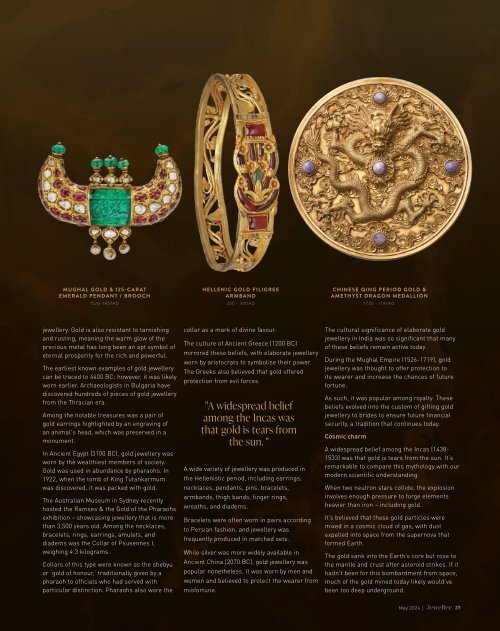Jeweller - May 2024
You also want an ePaper? Increase the reach of your titles
YUMPU automatically turns print PDFs into web optimized ePapers that Google loves.
MUGHAL GOLD & 125-CARAT<br />
EMERALD PENDANT / BROOCH<br />
1526–1857AD<br />
HELLENIC GOLD FILIGREE<br />
ARMBAND<br />
200 - 300AD<br />
CHINESE QING PERIOD GOLD &<br />
AMETHYST DRAGON MEDALLION<br />
1736 - 1795AD<br />
jewellery. Gold is also resistant to tarnishing<br />
and rusting, meaning the warm glow of the<br />
precious metal has long been an apt symbol of<br />
eternal prosperity for the rich and powerful.<br />
The earliest known examples of gold jewellery<br />
can be traced to 4400 BC; however, it was likely<br />
worn earlier. Archaeologists in Bulgaria have<br />
discovered hundreds of pieces of gold jewellery<br />
from the Thracian era.<br />
Among the notable treasures was a pair of<br />
gold earrings highlighted by an engraving of<br />
an animal's head, which was preserved in a<br />
monument.<br />
In Ancient Egypt (3100 BC), gold jewellery was<br />
worn by the wealthiest members of society.<br />
Gold was used in abundance by pharaohs. In<br />
1922, when the tomb of King Tutankarmum<br />
was discovered, it was packed with gold.<br />
The Australian Museum in Sydney recently<br />
hosted the Ramses & the Gold of the Pharaohs<br />
exhibition – showcasing jewellery that is more<br />
than 3,500 years old. Among the necklaces,<br />
bracelets, rings, earrings, amulets, and<br />
diadems was the Collar of Psusennes I,<br />
weighing 4.3 kilograms.<br />
Collars of this type were known as the shebyu<br />
or ‘gold of honour,’ traditionally given by a<br />
pharaoh to officials who had served with<br />
particular distinction. Pharaohs also wore the<br />
collar as a mark of divine favour.<br />
The culture of Ancient Greece (1200 BC)<br />
mirrored these beliefs, with elaborate jewellery<br />
worn by aristocrats to symbolise their power.<br />
The Greeks also believed that gold offered<br />
protection from evil forces.<br />
"A widespread belief<br />
among the Incas was<br />
that gold is tears from<br />
the sun. "<br />
A wide variety of jewellery was produced in<br />
the Hellenistic period, including earrings,<br />
necklaces, pendants, pins, bracelets,<br />
armbands, thigh bands, finger rings,<br />
wreaths, and diadems.<br />
Bracelets were often worn in pairs according<br />
to Persian fashion, and jewellery was<br />
frequently produced in matched sets.<br />
While silver was more widely available in<br />
Ancient China (2070 BC), gold jewellery was<br />
popular nonetheless. It was worn by men and<br />
women and believed to protect the wearer from<br />
misfortune.<br />
The cultural significance of elaborate gold<br />
jewellery in India was so significant that many<br />
of these beliefs remain active today.<br />
During the Mughal Empire (1526-1719), gold<br />
jewellery was thought to offer protection to<br />
its wearer and increase the chances of future<br />
fortune.<br />
As such, it was popular among royalty. These<br />
beliefs evolved into the custom of gifting gold<br />
jewellery to brides to ensure future financial<br />
security, a tradition that continues today.<br />
Cosmic charm<br />
A widespread belief among the Incas (1438-<br />
1533) was that gold is tears from the sun. It’s<br />
remarkable to compare this mythology with our<br />
modern scientific understanding.<br />
When two neutron stars collide, the explosion<br />
involves enough pressure to forge elements<br />
heavier than iron – including gold.<br />
It’s believed that these gold particles were<br />
mixed in a cosmic cloud of gas, with dust<br />
expelled into space from the supernova that<br />
formed Earth.<br />
The gold sank into the Earth’s core but rose to<br />
the mantle and crust after asteroid strikes. If it<br />
hadn’t been for this bombardment from space,<br />
much of the gold mined today likely would’ve<br />
been too deep underground.<br />
<strong>May</strong> <strong>2024</strong> | 37

















